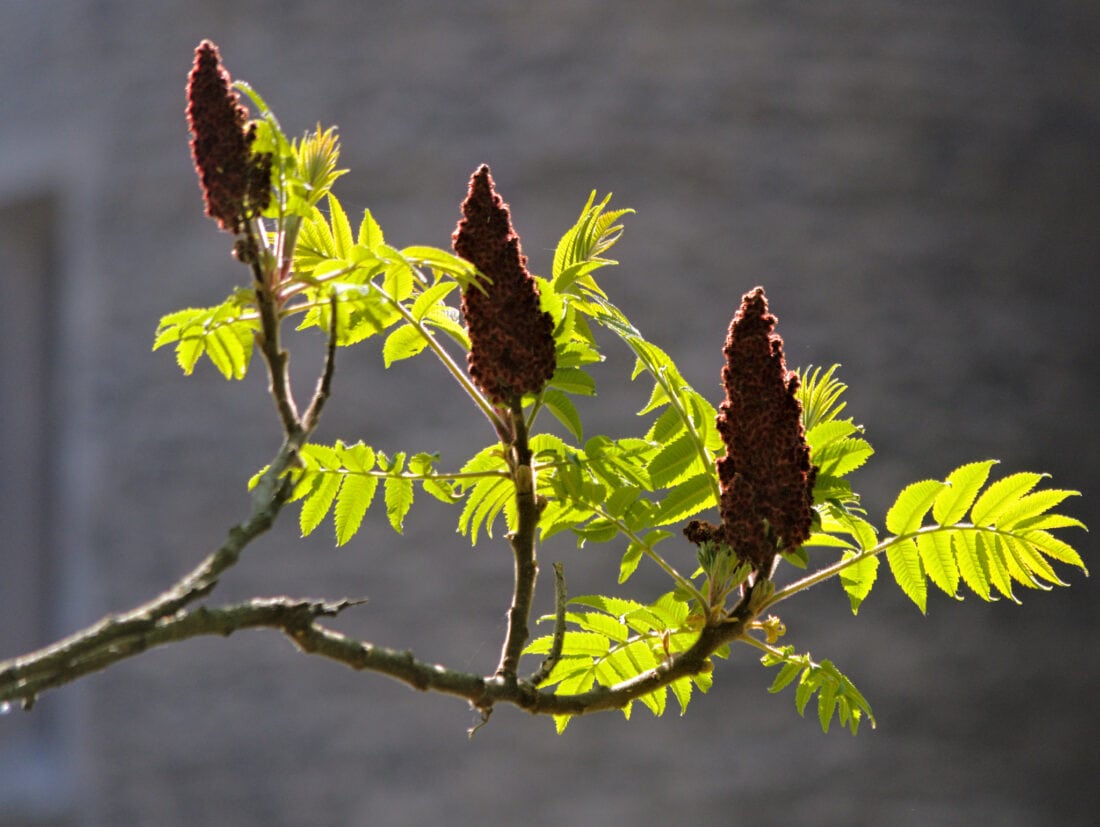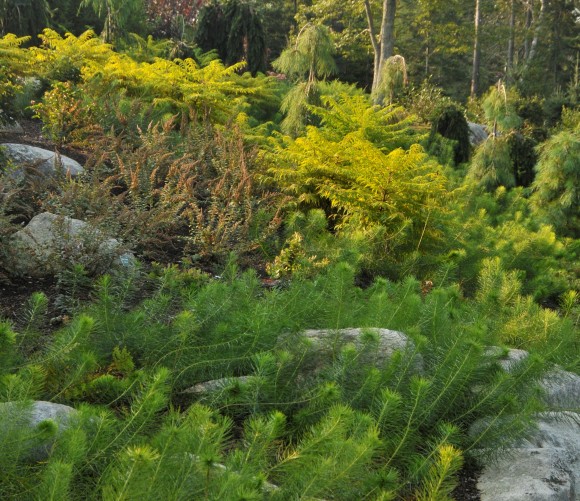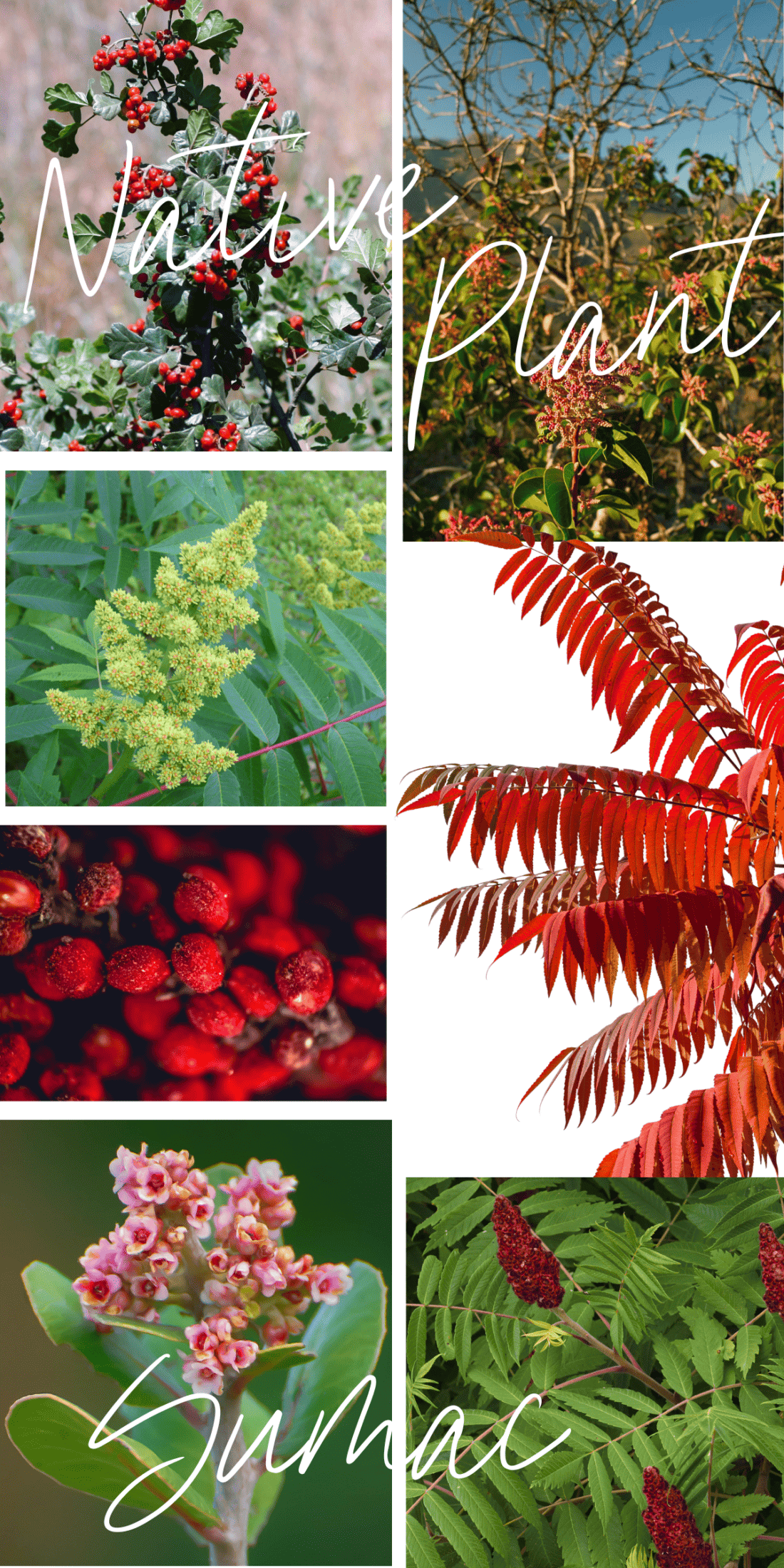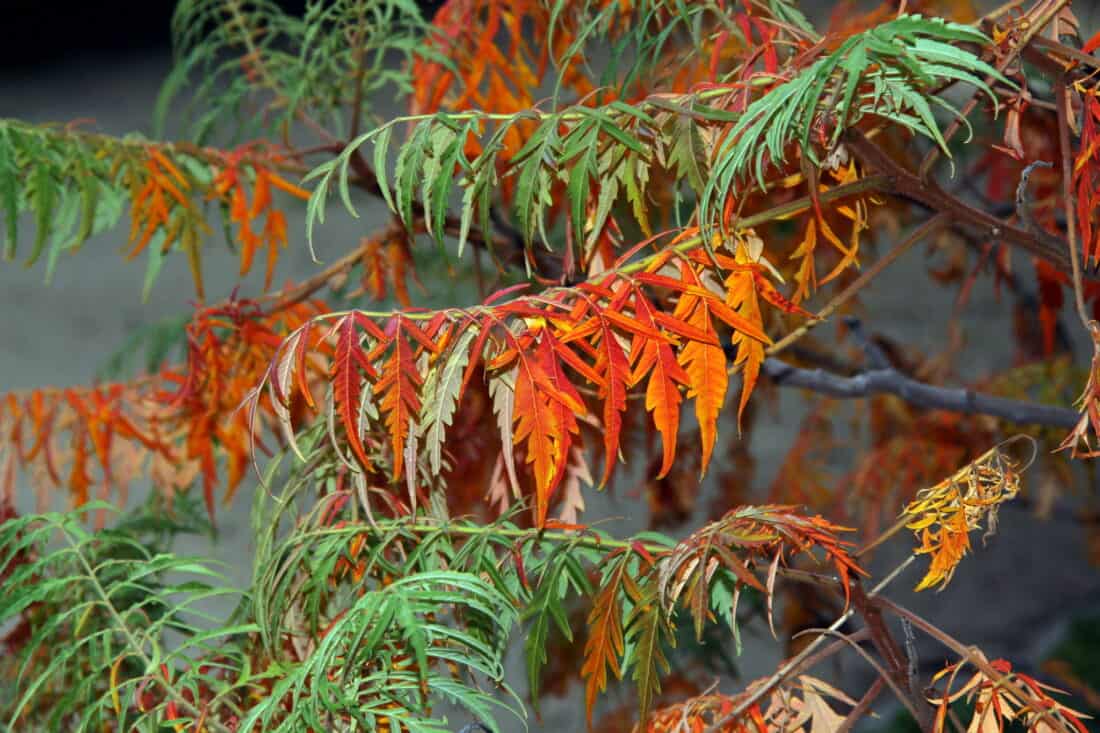Rhus typhina, commonly known as Staghorn Sumac, is a genus of plants known for their striking foliage and resilience. Within this diverse genus, one newer gem that truly stands out is Rhus Typhina ‘Tiger Eyes’. Renowned for its exceptional qualities, this cultivar features vivid golden foliage that seems to glow throughout the seasons. Staghorn Sumac tree, in general, is celebrated for its remarkable ability to thrive in various conditions and its capacity to add drama to the landscape. ‘Tiger Eyes,’ in particular, takes this natural charm to another level with its eye-catching leaves, making it a golden treasure for any garden.

Singing (literally) the praises of Rhus typhina ‘Tiger Eyes ‘
Remember that song, “Eye of the Tiger?” Oh, how we never grew tired of listening to it during the summers of our teen years, thinking that somehow, like Rocky Balboa, we would be able to conjure up the eye of the tiger in any situation. Even if we faced the biggest challenge of our life, which in the case of this song and Rocky III, happened to be the impenetrable Mr. T.
In that respect, I believe there could not be a more appropriate name for the chartreuse leaved selection of our native staghorn sumac but “Tiger Eyes.”
If you are about to throw in the towel on growing anything other than yews and hosta, jump back in the ring and give this plant a try. The true name of this beauty is Rhus typhina ‘Bailtiger.’ The cultivar is a patented name and Tiger Eyes is the trademark name.
Growing Tiger Eyes Staghorn Sumac Tree
I first came across Rhus typhina or staghorn sumac while in college. It seemed to be the perfect plant.
Staghorn sumac would grow almost anywhere but usually best in partial sun. The plant has beautiful, tropical-like, compound leaves and fuzzy stems that are more pronounced after the leaves drop in the fall. These fuzzy stems are reminiscent of deer antlers, thus the inspiration for the common name.
The staghorn sumac usually tops out around 6 feet tall and wide. Another wonderful characteristic is the orange-red fall color.
Staghorn Sumac Can be Aggressive (but it is easy to pull).
So, what is not to love about this small tree? Well, I soon found out a couple of years after I planted one at my mother’s home.
When staghorn sumac is happy, let’s just say, it makes it self at home. It can run in loose soil and I saw plants 5 feet away from the original plant within 3 years.
Staghorn sumac spreads by stolons so it is best to keep it in a container or enclosed planting bed. But, if you are looking for a native plant that is a fighter, this is a great plant to consider.

I had always liked this plant but its reputation to put up a fight had gotten out on the street. Very few gardners with Sumac experience people would consider it anymore for the garden.
Then, Tiger Eyes came into the scene and allowed staghorn sumac to make a comeback.
The first plant I saw was in a container at Longwood Gardens. The gardener had beautifully combined Tiger Eyes sumac with other native plants for a striking container combination.
When set against a darker colored backdrop such as an evergreen tree or dark house, the chartreuse foliage on Tiger Eyes comes to life like Rocky after a pep talk from his trainer, Mickey.
We have a massing of this plant on the Haney Hillside Garden at Coastal Maine Botanical Garden. The color and texture of the foliage is echoed by Amsonia hubrichtii planted en masse in the foreground.
– Rodney

Other Sumac Varieties worth exploring:
- Rhus typhina (Staghorn Sumac): Staghorn Sumac is native to eastern North America and known for its stunning, velvety red, and conical fruit clusters that resemble antlers. It’s a hardy and adaptable plant, attracting birds with its fruit and adding vibrant fall color to your landscape. Grow it for its visual interest and wildlife appeal.
- Rhus glabra (Smooth Sumac): Native to North America, Smooth Sumac produces dense clusters of bright red berries in late summer. These berries are a valuable food source for birds and can be used to make a lemony-flavored drink called “sumac-ade.” Grow it for its ecological benefits and unique beverage potential.
- Rhus aromatica (Fragrant Sumac): Found across eastern and central North America. If you crush the foliage, you’ll understand why Fragrant Sumac has its name. I’d describe it as a spicy citrus scent. It’s a tough, low-maintenance shrub that can serve as ground cover in dry, rocky areas. Its adaptability and lovely scent make it a great choice for xeriscaping.
- Rhus coriaria (Sumac): Although not native to the USA, this sumac is globally recognized for its culinary and medicinal uses. It is often referred to as Sicilian Sumac. (It is native to southern Italy and all of the Mediterranean basin). Also referred to as tanners sumac (for high tannins used in tanning) and sumac spice. Its red berries are dried and ground into a tangy spice used in Middle Eastern cuisine called Za’atar. Grow it for its unique culinary potential and cultural significance.
- Rhus integrifolia (Lemonade Berry): Native to California and Baja California. Lemonade Berry is drought-tolerant and features glossy, leathery leaves with a lemony scent when crushed. Use Its berries to make a refreshing drink, resembling lemonade (except that it is pink). The Native American Kumeyaay used tangy huutat (their name for this plant) berries to flavor their tea. Grow it for its fragrant foliage and potential as a drought-resistant landscape plant.
- Rhus ovata (Sugar Bush): Also native to California. Sugar Bush is known for its dense, evergreen foliage and small, red berries. It’s a valuable plant for wildlife and can serve as a windbreak or screen in native gardens. Grow it for its year-round greenery and ecological benefits.
Each of these Rhus varieties offers something unique. From striking foliage and vibrant fall color to culinary uses and wildlife attraction. They are all intriguing choices for gardeners with diverse interests.
New Staghorn and other Sumac Tree Cultivars:
Rhus typhina ‘Tiger Eyes’ (Tiger Eyes Sumac): Also know as Rhus typhina ‘Baitiger’. This cultivar of Staghorn Sumac boasts golden foliage that changes to orange and red in the fall. ‘Tiger Eyes’ is prized for its striking color transformations and makes a captivating focal point in any garden.
Rhus aromatica ‘Gro-Low’ (Gro-Low Fragrant Sumac): Similar to Fragrant Sumac but with a low-spreading growth habit, ‘Gro-Low’ is excellent for erosion control and creating naturalistic groundcovers. Its low profile and hardiness make it a favorite for preventing soil erosion on slopes.

Here are a few more interesting reasons to grow a Sumac tree (Rhus of all varieties) :
- Stunning Fall Foliage: Sumac boasts brilliant autumn colors, transitioning from vibrant green to fiery red and orange, adding a breathtaking spectacle to your landscape.
- Wildlife Attraction: The bright red Sumac berries provide a vital food source for birds during the winter months, making it a valuable addition for wildlife enthusiasts.
- Low Maintenance: Sumac is a hardy and drought-tolerant plant, requiring minimal care once established, making it ideal for busy gardeners.
- Erosion Control: Its spreading root system helps prevent soil erosion, making Sumac a natural choice for stabilizing sloped or hilly areas.
- Medicinal Uses: Some Native American tribes used Sumac for its medicinal properties, including soothing sore throats and digestive ailments.
- Landscaping Versatility: Sumac works well in various landscaping styles, from native gardens to formal landscapes, thanks to its adaptability.
- Unique Staghorn Appearance: Its distinctive fuzzy stems resemble the antlers of a deer, adding an intriguing and textured element to your garden. (I also like to use them in holiday decorations)
- Dye Production: Sumac leaves and berries can be used to create natural dyes, making it a fascinating plant for crafters and artisans.
- Culinary Delight: Sumac is a key ingredient in many culinary recipes, such as those by renowned chef Yotam Ottolenghi (my favorite Celeb Chef!) where its tangy, lemony flavor enhances a variety of dishes, from salads to marinades.
- High Tannins: The leaves and bark of Rhus typhina are high in tannins and can be used for tanning.
More posts about inspiring plants and garden design:
images winter greenhouse, Putneypics (by creative commons), and William Cullina, FarOutFlora, emmapatsie, manuel m. v., Andreas Rockstein, Superior National Forest, David A. Hofmann, Wayne S. Grazio, Michael Eric Nickel


+comments+